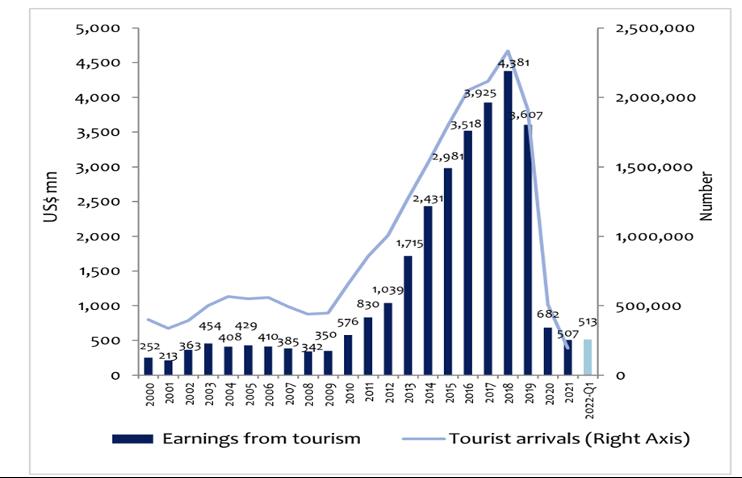(MENAFN- Asia Times)
The tourism sector plays a key role in Sri Lanka's economy by providing it with employment, bringing in foreign exchange and providing much-needed revenue for the government.
Tourism makes up 12% of the nation's gross domestic product and has become the third-largest source of foreign exchange. In 2018, an impressive 2.3 million tourists visited the country, the nation US$4 billion to $5 billion in revenues, and 40,000 jobs to the economy.
The Easter Sunday bombings of April 2019 that killed 250 people were the start of a downfall of Sri Lanka's tourism industry. Among those killed were 42 foreign nationals who were visiting Sri Lanka. After this, some countries put out travel advisories warning citizens to avoid travel to the nation. Tourists made a hasty exit, and new arrivals dropped by 70% in May and 60% in June compared with the previous year.
For a while it seemed that the tourism industry would bounce back as revenues grew again toward the end of 2019 to $3.5 billion, but the Covid-19 pandemic and the war between Russia and Ukraine dragged down Sri Lanka's tourism sector again. The current economic crisis has made recovery tricky for the sector.
History of ups and downs
When looking at the historical contribution of tourism to Sri Lanka's economy, we find that the government started adopting policies to promote tourism toward the 1960s. Better accommodation facilities and travel infrastructure were set up to attract tourists.
Sri Lanka liberalized its economy in the late 1970s, which brought in investments in the tourism sector.
The Sri Lankan Civil War that started in 1983 the tourism potential of the nation. Initially the tourism flow remained relatively unaffected as the violence was restricted to the northern parts of the country. But this changed from 1995 when the attacks affected Colombo as well.
Another blow to the tourism sector was the 2008 global financial crisis. But after 2010, the tourism sector witnessed a steep rise and became the of the Sri Lankan economy. Tourism made up 5.6% of Sri Lanka's GDP by 2018.
In 2020, however, things changed for the worse as the pandemic and related travel restrictions caused revenues to fall steeply, by 50%. The contribution of tourism to Sri Lanka's GDP fell to only 0.8%. The decline of tourists from China and European countries affected Sri Lanka particularly badly.

Tourist arrivals and earnings in Sri Lanka (2000-22). Sources: Central Bank of Sri Lanka and Sri Lanka Tourism Development Authority
The tourism industry adds thousands of direct and indirect jobs to the Sri Lankan economy. The number of jobs added increased at a steady pace until the beginning of the Covid-19 pandemic.
The Russia-Ukraine war also wreaked havoc on Sri Lana's tourism sector. Tourists from Russia and Ukraine used to frequent Sri Lanka in large numbers. They formed only 10% of tourists in 2018, which then increased to 25% by January 2022. The war resulted in the share of Russian tourists falling to 10% while that of Ukrainian tourists fell to 3%.
The signs of recovery toward the end of 2021, highlighted by the massive increase in tourist arrivals in March 2022 (106,500) compared with March 2021 (4,581), was undone by the current economic crisis, which has the tourism sector in Sri Lanka in a bad way. Total tourist arrivals fell to 30,207 by May 2022. The government predicted that tourist arrivals would increase in July and August 2022, but fuel shortages played spoilsport and only 37,760 tourists visited in August.
The fall in the number of tourists was one of the factors that caused the foreign-exchange reserves to empty, causing the ongoing economic crisis. An increase in tourist inflow could undoubtedly have a positive impact on pulling the nation out of its current crisis.
Reviving the tourism industry
The efforts by the government to do so are on as the country prepares such as the Murugan-Shiva Shakthi trail to woo Indian tourists. As a result, India now makes up 16% of the total tourist arrivals in the country as of . Along with this, Sri Lanka must abandon practices such as imposing a on social-media sites as that will decrease confidence among tourists in viewing the nation as a viable tourist destination.
Tourism can play a key role in helping the country come out of its economic crisis. Tourism brings in valuable foreign exchange and creates jobs. Policies aimed at boosting the tourist footfall, combined with the scrapping of policies that create an unfavorable image of Sri Lanka in the mind of tourists, must be initiated.
With the ongoing war between Russia and Ukraine, Sri Lanka must find ways of increase tourism from alternative destinations for tourism to have any meaningful impact on the economy soon.
The author acknowledges Aravind J Nampoothiry at the National Law School of India University in Bangalore for his research assistance on this article.
MENAFN06102022000159011032ID1104977483
Legal Disclaimer:
MENAFN provides the information “as is” without warranty of any kind. We do not accept any responsibility or liability for the accuracy, content, images, videos, licenses, completeness, legality, or reliability of the information contained in this article. If you have any complaints or copyright issues related to this article, kindly contact the provider above.